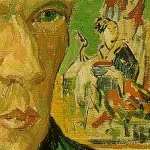That said, Gopnik got a lot wrong in his Van Gogh article. In fact, it's a glaring and rather frustrating example of a thoughtful writer unwittingly perpetuating the Mad Artist myth. (See my earlier post, "The Real Van Gogh, Part One.") Gopnik's key point, as he argues for the "decisive break [in Van Gogh's painting]marked by the Christmas crisis," is basically this: if Van Gogh had not gone crazy in Christmas 1888, cutting off his left ear, he would never have become the artist we know and revere, and the history of modern art would have been substantially different. Gopnik emphasizes that it was Van Gogh's "madness"--he tolls at this word repeatedly--that led him to new directions, that enabled him to create his most idiosyncratic and influential pictures.
Gopnik also passes on a newfangled argument by two German art historians that is getting a lot of press recently; namely, that it was Gauguin who actually cut off Van Gogh's ear (with a sword). The evidence for this, which Gopnik calls "arresting," seems awfully thin, and reeks of conspiracy thinking: private codes, enforced secrets, interpretations of latin phrases. But I'm far less concerned about his endorsing this peculiar version of what happened on December 23, 1888 then I am the above mentioned fallacy. First, most of the art historians I consulted when researching my novel agreed that Van Gogh's powers were at their peak in the summer and early fall of 1888. To me, looking at the paintings, this is self-evidently true. In fact, in letters from the hospital in Saint-Remy Van Gogh referred nostalgically to the "high yellow note" he previously worked in, explaining that since the sharp decline in his health it was not a style he could aspire to again. Indeed, the colors in his Saint Remy pictures are far muted, less striking; they do not scream off the canvas in quite the same way as the colors in his Arles pictures. This is not to say that Gogh did not paint impressives pictures at Saint-Remy and Auvers-sur-Oise; Gopnik names some of them; but it is to say that most of the pictures we know the man for, that we look at as breakthroughs--"The Sower," "The Sower with the Setting Sun," "Vincent's Bedroom," the "Sunflower" series, "The Night Cafe," "The Cafe at Night," "Starry Night Over the Rhone," his portraits of the postman Roulin and of the peasant farmer and of a zouave and of the Belgian Eugene Boch--were all completed prior to the arrival of Paul Gauguin in Arles in October of 1888. If he had simply stopped painting after the "Christmas Crisis" his place in art history would have bee more than secure, his influence already established.
[Next time, because I've already kept you for too long: What Gopnik got most wrong.]













0 comments:
Post a Comment